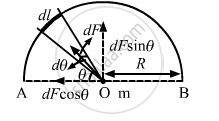Advertisements
Advertisements
Question
A semicircular wire has a length L and mass M. A particle of mass m is placed at the centre of the circle. Find the gravitational attraction on the particle due to the wire.
Solution
Consider a small mass element of length dl subtending dθ angle at the centre.

In the semicircle, we can consider a small element dθ.
Then length of the element, dl = R dθ
Mass of the element, dm \[= \left( \frac{M}{L} \right)R d\theta\]
Force on the mass element is given by
\[dF = \frac{Gm}{R^2}dm = \frac{GMRm}{L R^2}{d}{\theta}\]
The symmetric components along AB cancel each other.
Now, net gravitational force on the particle at O is given by
\[F = \int2dF\sin \theta\]
\[ = \int\frac{2GMm}{LR}\sin \theta d\theta\]
\[ \therefore F = \int_0^\pi/2 \frac{- 2GMm}{LR}\sin \theta d\theta\]
\[ = \frac{2GMm}{LR} \left[ - \cos \theta \right]_0^\pi/2 \]
\[ = - 2\frac{GMm}{LR}\left( - 1 \right)\]
\[ = \frac{2GMm}{LR} = \frac{2GMm}{LL/\pi}\]
\[ = \frac{2\pi G Mm}{L^2}\]
APPEARS IN
RELATED QUESTIONS
Write the formula to find the magnitude of the gravitational force between the earth and an object on the surface of the earth.
Calculate the force of gravitation between the earth and the Sun, given that the mass of the earth = 6 × 1024 kg and of the Sun = 2 × 1030 kg. The average distance between the two is 1.5 × 1011 m.
Answer the following:
You can shield a charge from electrical forces by putting it inside a hollow conductor. Can you shield a body from the gravitational influence of nearby matter by putting it inside a hollow sphere or by some other means?
State Kepler’s law which is represented by the relation r3 ∝ T2.
Universal law of gravitation states that every object exerts a gravitational force of attraction on every other object. If this is true, why don’t we notice such forces ? Why don’t the two objects in a room move towards each other due to this force ?
Let V and E be the gravitational potential and gravitational field at a distance r from the centre of a uniform spherical shell. Consider the following two statements :
(A) The plot of V against r is discontinuous.
(B) The plot of E against r is discontinuous.
A body is suspended from a spring balance kept in a satellite. The reading of the balance is W1 when the satellite goes in an orbit of radius R and is W2 when it goes in an orbit of radius 2 −R.
Two concentric spherical shells have masses M1, M2 and radii R1, R2 (R1 < R2). What is the force exerted by this system on a particle of mass m1 if it is placed at a distance (R1+ R2)/2 from the centre?
A ball is thrown vertically upwards. It goes to a height 20 m and then returns to the ground. Taking acceleration due to gravity g to be 10 ms-2 , find :
the total time of journey of the ball .
How will the force of gravitation between two objects change if the distance between them is:
Halved
Gravity is another kind of ________. It exerts all through the ________. The Sun's gravity keeps the ___________ in their orbits. Gravity can only be felt with very large ________.
Does the force of the earth's gravitation affect the motion of the moon? Explain your answer with reasons.
The distance-time values for an object moving along straight line are given below:
| Time (s) | Distance (m) |
| 0 | 0 |
| 1 | 1 |
| 2 | 8 |
| 3 | 27 |
Answer the following question.
State Newton’s law of gravitation and express it in vector form.
Solve the following problem.
Calculate the acceleration due to gravity at a height of 300 km from the surface of the Earth. (M = 5.98 × 1024 kg, R = 6400 km).
The value of universal gravitational constant (G) in the SI unit is ______.
For the weight of body of mass 5 kg to be zero on equator of the earth, angular velocity of the earth must be (The radius of earth = 6400 km, acceleration due to gravity = 10 m/s2).
We can shield a charge from electric fields by putting it inside a hollow conductor. Can we shield a body from the gravitational influence of nearby matter by putting it inside a hollow sphere or by some other means?
Complete the chart below.
| F(N) | M1(kg) | M2(kg) | D(m) |
| (a) | 50 | 84 | 02 |
| 16 × 109 | 1.63 × 1022 | (b) | 34 |
Newton's universal law of gravitation applies to ______.
